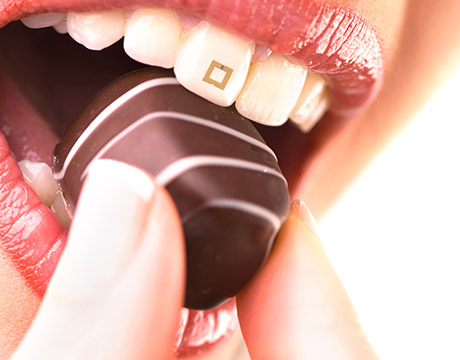Mini Sensor Detects and Measures What We Eat, Part 1
Mini Sensor Detects and Measures What We Eat, Part 1


Researchers have developed a miniaturized sensor that can transmit biodata. Image: Tufts University
Mention miniaturization and smart sensors and most people immediately think of better and smaller electronics. But nowhere are advancements in sensor technology, as well as materials science and engineering, having greater impact than in the medical field.
Developments are leading to more and more noninvasive wearable devices for personalized healthcare. This allows continuous, real-time patient monitoring and assessment of everything from glucose levels and temperature changes to blood pressure and neurological functions.
Now researchers at the Tufts University School of Engineering have developed miniaturized sensors that mount on a tooth and continuously track what a person eats. In real time, data is transmitted wirelessly via radio waves to a digital device such as a mobile phone. Experts believe such information will help health care specialists find links between what people eat and their health.
Naturally derived materials have a lot of opportunity for interfaces and functionalization and also offer opportunity to bring together technology and biology. Dean Fiorenzo Omenetto, Tufts University
For You: Read the latest bioengineering research at asme.org
In an article scheduled for publication in Advanced Materials News, the researchers describe the process in which the sensor transmitted information on glucose, salt, and alcohol. They tested people after they gargled mouthwash, drank apple juice, alcohol, soup, and water as well as tested them with a dry mouth. The researchers believe these sensors can be adapted to transmit a much wider variety of information that could enable the detection and recording of many nutrients, chemicals, and physiological states.
The work is taking place in the Ultrafast Nonlinear Optics and Advanced Biomaterials Technology Lab and led by Fiorenzo Omenetto, dean of research in the school of engineering and professor of biomedical engineering at Tufts.
“We’re basically a biomaterials group,” Omenetto says. “Naturally derived materials have a lot of opportunity for interfaces and functionalization and also offer opportunity to bring together technology and biology. We transform proteins into a multitude of formats. We look at devices that can be implanted.”
The tiny sensor Omenetto’s team developed is flexible enough to conform and bond to the irregular surface of a tooth. They describe it as operating much like a highway toll system works, with sensors transmitting data wirelessly in response to an incoming radiofrequency signal.
The 2mm-by-2mm sensor is made up of three layers, a central layer of material that absorbs the nutrient encapsulated between layers of square-shaped gold rings, which are reverse-facing split ring resonators. When the middle layer absorbs the nutrients, it swells and the gold rings move apart. Together, the three layers act like a tiny antenna, collecting and transmitting waves in the radio frequency spectrum. The type of nutrient detected ascertains the spectrum and intensity of the radio frequency waves transmitted, enabling identification and measurement of the nutrient.
Part 2 of “Mini Sensor Detects and Measures What We Eat” explores how the team built the device and the changes future versions of it will undergo.
Nancy Giges is an independent writer.
Read More:
Solar-Powered DronesGo Mainstream
Artificial Intelligence Transforms Manufacturing
Handheld "Dronut" Brings Drones Indoors



